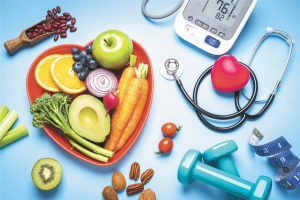

But first, what is cholesterol.
Cholesterol is a waxy, fat-like substance made naturally by your liver. It is essential to perform various functions in the right amounts, such as making sex hormones, digesting fatty foods, and converting sunlight into vitamin D.
Cholesterol travels through our blood on proteins called lipoproteins. One type – low-density lipoprotein (LDL) – is coined the “bad” cholesterol, as high levels lead to a buildup of plaque in your arteries. Arteries + plaque buildup = an increased risk of heart disease. Another type – high-density lipoprotein (HDL) – is considered the “good” cholesterol. HDL carries cholesterol and plaque from our arteries back to our liver, so it can be flushed from the body.
Cholesterol levels vary naturally by age, weight, and sex. Total and LDL cholesterol levels should be low. But having more HDL, or “good,” cholesterol in the blood may balance the “bad” by reducing the risk of a heart attack or stroke.
AHA-recommended cholesterol levels.
• Total cholesterol levels: under 200 mg/dl (milligrams per deciliter)
• LDL: less than 100 mg/dl
• HDL: Men – 40 mg/dl or higher Women – 50 mg/dl or higher
Cholesterol and nutrition connection.
Your diet plays an important purpose in maintaining cardiovascular health, so it’s reasonable to think eating cholesterol-rich foods will raise your cholesterol levels. However, the connection isn’t quite that simple. The cholesterol we get from our diets comes from eating animal products – namely meat and dairy, which are also factors in saturated fat.
So, while foods rich in cholesterol minimally increase blood cholesterol, saturated fat is of greater concern.
According to the AHA, saturated fat is a bigger culprit for raising blood cholesterol, in general, than dietary cholesterol.
Heart-healthy foods.
Changing the foods you eat can lower your cholesterol and improve the flow of fats in your blood.
• Increase soluble fiber. Soluble fiber reduces cholesterol absorption into your bloodstream and lowers blood pressure. It is also perhaps the easiest dietary impact on your heart health. Oats and other whole grains are an easy addition to your meals or snacks (think oatmeal, Cheerios, granola bars, whole grain rice). Many fruits – especially the exotic type – are super rich in fiber, including raspberries, strawberries, apples (mainly in the peel), bananas, mango, and guava. In general, the darker-colored the vegetable, the higher the fiber content. Carrots, beets, and broccoli are good choices. Artichokes are among the highest-fiber veggie.
Beans are fiber-packed and high in protein, so they are a healthy, filling substitute for red meats. They make great soups and are a flavorful addition to salads. These are a good choice for your shopping cart: garbanzo, Northern white, lima, or pinto beans.
• Reduce saturated fats. Saturated fats, found primarily in red meat, are the primary culprit of high cholesterol. Steak, beef roast, ribs, pork chops, and ground beef all tend to have high saturated fat and cholesterol content. Choose lean (90 percent lean) cuts or beef or pork, such as sirloin, filet, flank, pork loin, or tenderloin. Better still – focus on lower fat sources such as chicken or turkey filets or ground.
Avoid fried foods, which are high in saturated fat and cholesterol due to the oil they’re soaked in. Instead, opt for olive or avocado oil and choose healthier cooking methods, like grilling, baking, or air frying.
• Eggs. Eggs are a great source of protein and low in calories, but they tend to get a bad rap. Eggs are low in saturated fat and calories but can be high in calories.
This may be due to how eggs are prepared, such as frying in oils or butter. Water-poached, hard-boiled eggs, or egg whites are healthy substitutes for meats.
• Eat foods rich in omega-3 fatty acids. Eating fish two or three times a week can lower LDL in two ways: by replacing meat, which has LDL-boosting saturated fats, and by delivering LDL-lowering omega-3 fats. Foods with omega-3 fatty acids include salmon, mackerel, herring, walnuts, and flaxseeds. Omega-3s reduce triglycerides in the bloodstream and protect the heart by helping prevent the onset of abnormal heart rhythms.
• Lower dairy fats. Whole milk, full-fat yogurt, cheese, and butter are super high in saturated fat. Instead, opt for skim (non-fat), 1% or 2% milk, and non-fat or low-fat yogurt varieties for calcium intake. Limit cheeses and choose part-skim (Swiss, mozzarella, ricotta) when possible. Use extra-virgin olive oil or avocado oil instead of butter.
• Add whey protein. Whey protein, found in dairy products, may account for many health benefits of dairy.
• Nuts. Studies show that eating almonds, walnuts, peanuts, and other nuts are good for the heart.
What we eat can impact our cholesterol levels and help reduce our risk of heart disease. The American Heart Association recommends following a heart-healthy diet. So, the next time you go to the grocer, stock up on some of the above.
At IntuneHealth, we provide proactive, preventative care designed to keep you healthy. IntuneHealth takes the hassle out of health care giving you direct access to your primary care physician, a personal care team coordinating all aspects of your care, and an all-in-one app to manage your health. With virtual, in-office, and in-home appointments, access to care is conveniently available when and where you need it. Schedule an appointment today to meet your new partner in health.
A new approach to primary care for
those with a Medicare Advantage plan.
(239) 790-1122 | IntuneHealth.com
 Southwest Florida's Health and Wellness Magazine Health and Wellness Articles
Southwest Florida's Health and Wellness Magazine Health and Wellness Articles

